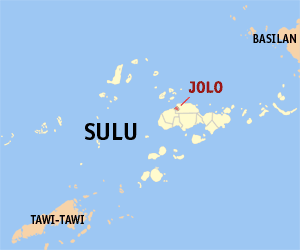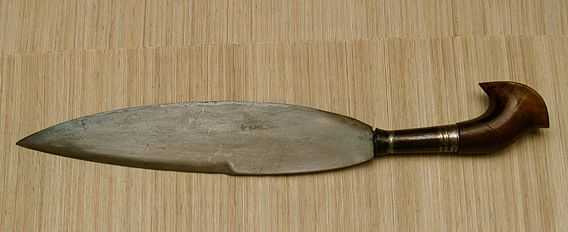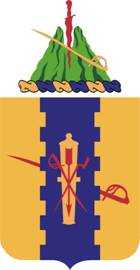First Battle of Bud Dajo
| First Battle of Bud Dajo | |||||||
|---|---|---|---|---|---|---|---|
| Part of the Moro Rebellion | |||||||
 U.S. soldiers pose with Moro dead after the battle | |||||||
| |||||||
| Belligerents | |||||||
|
|
| ||||||
| Commanders and leaders | |||||||
|
General Leonard Wood Col. Joseph W. Duncan | |||||||
| Strength | |||||||
| 750[1]:151 | 800 to 900 including women and children | ||||||
| Casualties and losses | |||||||
|
21 killed, 70 wounded[1]:170 | 800-900 killed[1]:169 | ||||||
The First Battle of Bud Dajo, also known as the Battle of Mt. Dajo, was a counter insurgency action fought by the United States Army against native Moros in March 1906, during the Moro Rebellion phase of the Philippine–American War. While fighting was limited to ground action on Jolo Island in the Sulu Archipelago, use of naval gunfire contributed significantly to the overwhelming firepower brought to bear against the Muslim insurgents, who were mostly armed with melee weapons. The description of the engagement as a battle is disputed because of both the overwhelming firepower of the attackers and the lopsided casualties. The conflict, especially the final phase of the battle, is also known as the Moro Crater Massacre.
During this battle, 790 men and officers, under the command of Colonel J.W. Duncan, assaulted the volcanic crater of Bud Dajo (Tausūg: Būd Dahu), which was populated by 800 to 1000 Moro villagers, including women and children. According to Herman Hagedorn (who was writing prior to World War II), the position held by the Moros was "the strongest which hostiles in the Philippines have ever defended against American assault." (pg. 64) Although the battle was a victory for the American forces, it was also an unmitigated public relations disaster. It was the bloodiest of any engagement of the Moro Rebellion, with only six of the hundreds of Moro coming out of the battle alive.[2] Estimates of American casualties range from fifteen killed [3] to twenty-one killed and seventy-five wounded.[2]
Background

The first battle at Bud Dajo happened during the final days of General Leonard Wood's term as governor of the Moro Province. Wood's term was a time of great reform. Some of these reforms, including the abolition of slavery and the imposition of the cedula - a registration poll tax - were less than popular with his Moro subjects. The cedula was especially unpopular, since the Moros interpreted it as a form of tribute, and according to Vic Hurley, Moro participation in the cedula was very low even after 30 years of American occupation.[4] These reforms, coupled with the general resentment of foreign Christian occupiers, created a tense and hostile atmosphere during Wood's tenure, and the heaviest and bloodiest fighting during the American occupation of Mindanao and Sulu took place under his watch.
Although Moro hostilities died down during the latter days of Wood's governorship (the tenure of Wood's replacement, General Tasker H. Bliss, was a period of relative peace), it was in this tense atmosphere of Moro resentment that the events leading to the Battle of Bud Dajo played out. According to Hermann Hagedorn, the Moro rebels of Bud Dajo were "the rag-tag-and-bobtail remnants of two or three revolts, the black sheep of a dozen folds, rebels against the poll tax, die-hards against the American occupation, outlaws recognizing no datto and condemned by the stable elements among the Moros themselves." (pg. 64) Vic Hurley, author of Swish of the Kris, adds that “the causes contributing to the battle of Bud Dajo were resentment over the curtailing of slave-trading, cattle-raiding, and women-stealing privileges of the Moros of Sulu.”[2]
Road to Bud Dajo
The chain of events leading to Bud Dajo began when a Moro named Pala ran amok in British-held Borneo. (The Moros differentiate between the religious rite of the juramentado and the strictly secular violence of the amoks, Pala's rampage was of the latter.) Pala then went to ground at his home cotta near the city of Jolo (the seat of the Sultan of Sulu), on the island of Jolo. Colonel Hugh L. Scott, the governor of the District of Sulu, attempted to arrest Pala, but Pala's datu opposed this move. During the resulting fight, Pala escaped. He avoided capture for several months, setting up his own cotta and becoming a datu in his own right. Wood led an expedition against Pala but was ambushed by Moros from the Bud Dajo area with the help of Pala. Wood beat off the ambushers, and many of them found refuge in the crater of Bud Dajo. Wood determined that the Moros held too strong of a position to assault with the forces at hand, and so he withdrew. (Lane, pg. 127)
Bud Dajo lies 6 miles (10 km) from the city of Jolo and is an extinct volcano, 2,100 feet (640 m) above sea level, steep, conical, and has thickly forested slopes. Only three major paths lead up the mountain, and the thick growth kept the Americans from cutting new paths. However, there were many minor paths, known only to the Moros, which would allow them to resupply even if the main paths were blocked. The crater at the summit is 1,800 yards in circumference and easily defended.[2] The mountain itself is eleven miles (18 km) in circumference, making a siege difficult.

Over the months that followed, the Bud Dajo rebels were joined by various outlaws, bringing the population of the crater up to several hundred. Water was plentiful, and the rebels began farming rice and potatoes. Scott sent the Sultan of Sulu and other high ranking datus to ask the rebels to return to their homes, but the rebels refused. Wood ordered an attack in February 1906, but Scott convinced him to rescind the order, arguing that the opposition of the surrounding datus would keep the rebels isolated. (Lane, 128) Scott was worried that an attack on Bud Dajo would reveal just how easily defended it was, encouraging repeats of the standoff in the future. (Smythe, 169) Unfortunately, the Bud Dajo rebels were emboldened by the American inaction, and began raiding nearby Moro settlements for women and cattle. Although the datus of Jolo continued to condemn the rebels, there began to develop popular support of a general uprising among the Moro commoners of Jolo. (Hagedorn, 64)
The crisis at Bud Dajo occurred during a period of transition in the leadership of the Moro Province. On February 1, 1906, Wood was promoted to the position of Commander of the Philippine Division, and was relieved as commander of the Department of Mindanao-Jolo by General Tasker H. Bliss. However, Wood retained his position as civil governor of the Moro Province until sometime after the Battle of Bud Dajo. Colonel Scott was absent during part of the crisis, and Captain Reeves, the deputy governor of the Sulu District, served as his substitute. (Hagedorn, pg. 63)
Battle


On March 2, 1906, Wood ordered Colonel J.W. Duncan of the 6th Infantry Regiment (stationed at Zamboanga, the provincial capital) to lead an expedition against Bud Dajo. Duncan and Companies K and M took the transport Wright to Jolo.[2] Governor Scott sent three friendly datus up the mountain to ask the Bud Dajo Moros to disarm and disband, or at least send their women and children to the valley. (Hagedorn, pg. 64) They denied these requests, and Scott ordered Duncan to begin the assault.
The assault force consisted of “272 men of the 6th Infantry, 211 [dismounted] men of the 4th Cavalry, 68 men of the 28th Artillery Battery, 51 Philippine Constabulary, 110 men of the 19th Infantry and 6 sailors from the gunboat Pampanga.”[2] The battle began on March 5, as mountain guns fired 40 rounds of shrapnel into the crater.[2] On March 6, Wood and Bliss arrived, but left Duncan in direct command. Captain Reeves, the acting governor of the District of Sulu, made one last attempt to negotiate with the rebels. (Hagedorn, pg. 64-65) He failed, and the Americans drew up into three columns and proceeded up the three main mountain paths. The columns were under the command of Major Bundy, Captain Rivers, and Captain Lawton.[2] The going was tough, with the troops ascending a 60% slope, using machetes to clear the path. (Hagedorn, pg. 65)
At 0700, March 7, Major Bundy's detachment encountered a barricade blocking the path, 500 feet (150 m) below the summit. Snipers picked off Moro defenders, and the barricade was shelled with rifle grenades. The barricade was then assaulted in a bayonet charge. The Moros staged a strong defense, then charged with kris (the traditional wavy-edged sword of the Moros) and spear. 200 Moros died in this engagement, and Major Bundy's detachment suffered heavy casualties. Captain Rivers' detachment also encountered a barricade, and took it after several hours of fighting, during which Rivers himself was severely wounded by a spear. Captain Lawton's detachment advanced up a poor path, so steep in places that the Americans proceeded on hands and knees. They were harassed by Moros hurling boulders and occasionally rushing to attack hand-to-hand with krises. Lawton finally took the defensive trenches on the crater rim by storm.[2]
The Moros retreated into the crater, and fighting continued until nightfall. During the night, the Americans hauled mountain guns to the crater's edge with block and tackle. At daybreak, the American guns (both the mountain guns and the guns of the Pampanga) opened up on the Moros' fortifications in the crater. The Moros, armed with krises and spears, refused to surrender and held their positions. Some of the defenders rushed the Americans and were cut down. The Americans charged the surviving Moros with fixed bayonets, and the Moros fought back with their kalis, barung, improvised grenades made with black powder and seashells. The defenders were wiped out.[2]
Out of the estimated 800 to 1,000 Moros at Bud Dajo, only 6 survived. Corpses were piled five deep, and many of the bodies were wounded multiple times. According to Hurley, American casualties were 21 killed, 75 wounded.[2] Lane lists them at 18 killed, 52 wounded. (pg. 128) Hagedorn says simply that “one-fourth of the troops actively engaged have been killed or wounded.” (pg. 65) By any estimate, Bud Dajo was the bloodiest engagement of the Moro Rebellion.
Aftermath

Following the American victory, President Theodore Roosevelt sent Wood a congratulatory cablegram, but reporters stationed at Manila had cabled their own account to the press. The March 11, 1906 New York Times headlines read, “WOMEN AND CHILDREN KILLED IN MORO BATTLE; Mingled with Warriors and Fell in Hail of Shot. FOUR DAYS OF FIGHTING Nine Hundred Persons Killed or Wounded—President Wires Congratulations to the Troops.”[5]
The press' account of the "Moro Crater Massacre" fell on receptive ears. There were still deep misgivings among the American public about America's role during the Spanish-American War and the stories of atrocities carried out during the Philippine- American War. The public had also been largely unaware of the continuing violence in the Moro Province, and were shocked to learn that killing continued. (Lane, pg. 129) Under pressure from Congress, Secretary of War William Howard Taft cabled Wood for explanation of the “wanton slaughter” of women and children. Despite not being in command of the assault (although he was the senior officer present), Wood accepted full responsibility. By the time the scandal died down, Wood had assumed his post as Commander of the Philippine Division, and General Tasker H. Bliss had replaced him as governor of the Moro Province.
In response to criticism, Wood's explanation of the high number of women and children killed stated that the women of Bud Dajo dressed as men and joined in the combat, and that the men used children as living shields. (Lane, pg. 129) Hagedorn supports this explanation, by giving an account of Lt. Gordon Johnston, who was severely wounded by a woman warrior. (pg. 65) A second explanation was given by the Governor-General of the Philippines, Henry Clay Ide, who reported that the women and children were collateral damage, having been killed during the artillery barrages. (Lane, pg. 129) These conflicting explanations of the high number of women and child casualties brought accusations of a cover-up, adding to the criticism. (Lane, pg. 129)
Some of Wood's critics accused him of seeking glory by storming the crater rather than besieging the rebels. Wood did show some signs of being a glory-hound earlier in his tenure as the governor of the Moro Province, taking the Provincial Army on punitive raids against cottas over minor offenses that would have been better left to the district governors. This heavy-handedness jeopardized relations with friendly datus, who viewed the encroachment of the army as a challenge. (Lane, pg. 125) Wood badly needed military laurels, since he had gone through an uphill United States Senate battle over his appointment to the rank of Major General, which was finally confirmed in March 1904. Although Wood had served as an administrator in Cuba, he had seen only a hundred days of field service during the Spanish-American War. (Lane, pg. 126) Wood had been promoted over the heads of many more senior officers, bringing charges of favoritism against President and fellow Rough Rider Teddy Roosevelt. Even though his promotion had been confirmed, Wood's reputation still suffered. Wood's willingness to take responsibility for Bud Dajo did much to improve his reputation within the army.
Wood argued that besieging Bud Dajo would have been impossible, given the ample supplies of the rebels, the 11-mile circumference of the mountain, the thickly forested terrain, and the existence of hidden paths up the mountainside. During the Second Battle of Bud Dajo, in December 1911, General “Black Jack” Pershing (the third and final military governor of the Moro Province) did succeed in besieging Bud Dajo, by cutting a lateral trail which encircled the mountain, 300 yards downhill from the crater rim. This cut off the Moros in the crater from the hidden mountainside paths. (Smythe, pg. 170) However, the tactical situation facing Pershing in 1911 was far different from that facing Wood in 1906.
See also
References
- ↑ 1.0 1.1 1.2 Arnold, J.R., 2011, The Moro War, New York: Bloomsbury Press, ISBN 9781608190249
- ↑ 2.0 2.1 2.2 2.3 2.4 2.5 2.6 2.7 2.8 2.9 2.10 The Battle of Bud Dajo (archived from the original on 2008-05-09), chapter 19 of Swish of the Kris (archived from the original on 2008-02-02), by Vic Hurley.
- ↑ Pacifying the Moros: American Military Government in the Southern Philippines, 1899-1913, Charles Byler, Ph.D
- ↑ The Formation of the Moro Province (archived from the original on 2008-05-12), chapter 18 of Swish of the Kris (archived from the original on 2008-02-02), by Vic Hurley.
- ↑ "WOMEN AND CHILDREN KILLED IN MORO BATTLE". The New York Times. March 11, 1906. Retrieved 24 September 2013.
- US Army Counterinsurgency and Contingency Operations Doctrine, 1860-1941. United States Government Printing, 1997.
- Hagedorn, Hermann. Leonard Wood: A Biography, vol. 2. United States: Harper & Brothers, 1931.
- Hurley, Vic. Swish of the Kris. (originally published E.P. Dutton & Co., Inc., 1936.) Available online
- Lane, Jack C. Armed Progressive. San Rafael, California: Presidio Press, 1978.
- Smyth, Donald. Guerrilla Warrior: The Early Life of John J. Pershing. New York: Charles Scribner's Sons, 1973.
Coordinates: 6°00′47″N 121°03′25″E / 6.013°N 121.057°E
External links
- Map and timeline
- What happened at Bud Dajo
- Responses to the Moro Massacre an overview of Anti-Imperialism history in the United States
- Swish of the Kris by Vic Hurley
- Mass-murdering Moro Muslims engage US-Army: battles of Bud Dajo and Bud Bagsak - History; Article.